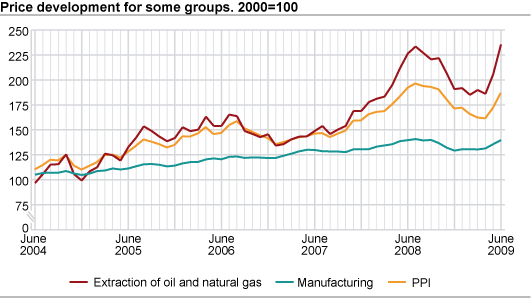Content
Published:
This is an archived release.
Higher prices of energy goods
A strong increase in the prices of energy goods caused the Norwegian producer price index to rise by 8.7 per cent from May to June.
The prices of energy goods increased by 13.4 per cent from May to June. Similarly to last month’s growth in the overall index, it was higher prices of crude oil and refined petroleum products that contributed the most. In addition, 10.1 per cent higher electricity prices made an important contribution this month. One possible explanation for the increase in the electricity prices from May to June may be that the water reservoir levels are somewhat below normal for this time of the year.
Price rise in manufacturing due to petroleum and metals
Most manufacturing industries experienced only moderate price changes from May to June. Higher prices of refined petroleum products and basic metals gave a 2.7 per cent rise in the manufacturing, mining and quarrying industries seen as a whole. The price increase of refined petroleum products can be seen in relation to the recent price growth of crude oil. 4 per cent higher prices of non-ferrous metals made the most important contribution to the overall increase for basic metals. Several of the non-ferrous metals traded on the London Metal Exchange (LME) , including nickel and aluminium, became more expensive in June compared to May.
Refined oil products and basic metals disregarded, prices in manufacturing seen as a whole remained about unchanged over the last month.
Twelve month change: Producer prices up 0.8 per cent
The producer price index rose by 0.8 per cent from June last year to June this year. This increase was mainly due to higher prices in extraction of crude oil and natural gas. Prices in manufacturing fell moderately over the last twelve months. The main cause was lower prices on refined petroleum products and basic metals, which experienced 19.8 and 15.8 per cent drop in prices respectively.
Even though manufacturing as a whole demonstrate a moderate decrease, the price development of the domestic and exports markets differ somewhat over the last twelve months. The last half of 2008 was characterized by decreasing prices in both markets. Up until June this year, the price development in the domestic market has been fairly stable, while the exports market has experienced a rather strong increase in prices since April.
| June 2009 | Changes, per cent | ||||||||||||||||||||||||||||||||||||||
|---|---|---|---|---|---|---|---|---|---|---|---|---|---|---|---|---|---|---|---|---|---|---|---|---|---|---|---|---|---|---|---|---|---|---|---|---|---|---|---|
| May 2009 - June 2009 | June 2008 - June 2009 | ||||||||||||||||||||||||||||||||||||||
| Total index | 187.0 | 8.7 | 0.8 | ||||||||||||||||||||||||||||||||||||
| Extraction of oil and natural gas | 235.5 | 14.5 | 1.9 | ||||||||||||||||||||||||||||||||||||
| Manufacturing, mining and quarrying | 139.7 | 2.7 | 0.0 | ||||||||||||||||||||||||||||||||||||
| Electricity, gas and steam supply | 266.4 | 10.1 | -2.3 | ||||||||||||||||||||||||||||||||||||
| Main industrial groupings | |||||||||||||||||||||||||||||||||||||||
| Intermediate goods | 128.5 | 0.2 | -3.1 | ||||||||||||||||||||||||||||||||||||
| Investment goods | 126.9 | 0.7 | 8.6 | ||||||||||||||||||||||||||||||||||||
| Consumer goods | 122.8 | 0.3 | 6.0 | ||||||||||||||||||||||||||||||||||||
| Energy goods | 232.8 | 13.4 | -0.7 | ||||||||||||||||||||||||||||||||||||
For information on the commodity price index for the industrial sectors, see http://www.ssb.no/vppi
Additional information
Contact
-
Producer price index
E-mail: produsentpris@ssb.no
tel.: (+47) 21 09 40 00
-
Elisabeth Mælum
E-mail: elisabeth.maelum@ssb.no
tel.: (+47) 97 01 28 49
-
Morten Madshus
E-mail: morten.madshus@ssb.no
tel.: (+47) 40 90 26 94
-
Monika Græsli Engebretsen
E-mail: monika.graesli.engebretsen@ssb.no
tel.: (+47) 40 90 23 71
-
Håvard Georg Jensen
E-mail: havard.jensen@ssb.no
tel.: (+47) 40 90 26 86

